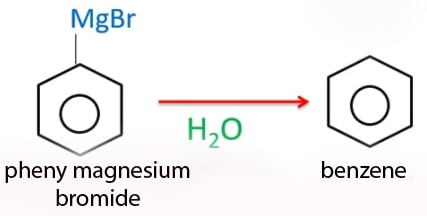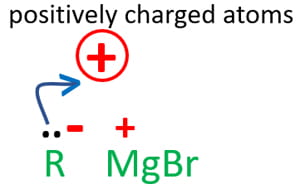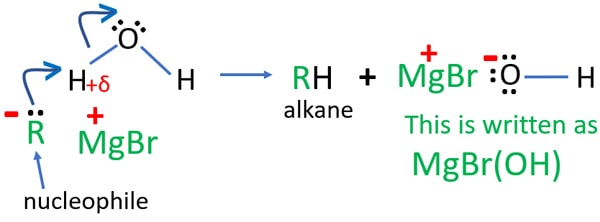Grignard Reaction with Water | Hydrolysis of Grignard Reagent
Grignard reagent hydrolysis in the water and give an alkane as the product. Therefore, grignard reagent cannot be stored in aqueous phases.
Hydrolysis of grignard reagent in water
Grignard reagent is highly unstable in water and form an alkane compound after hydrolysis. This is the reason why grignard reagent should be prepared in a dry medium (without water or moisture).

Grignard reagent + water → alkane + MgX(OH)
Alkane is given such as protecting number of carbon atoms contains in the grignard reagent.
If we represent grignard reagent as RMgX, after adding water RH and MgX(OH) are given as products.
Here X is the halogen (chlorine or bromine or iodine)
RMgX + H2O → RH + MgX(OH)
Now, we are going to see some examples for hydrolysis of grignard reagent.
Methyl magnesium bromide and water reaction
Methyl magnesium bromide (CH3MgBr) reacts with water and produce methane as the organic product. As an another product, MgBr(OH) is given

Ethyl magnesium chloride and water
As methyl magnesium bromide, ethyl magnesium chloride will reacts with water and hydrolysis. It gives ethane as the product while MgCl(OH) is given as the by-product during the reaction.

Phenyl magnesium bromide and water
Phenyl magnesium bromide, an aromatic grignard compound hydrolysis to give benzene as the product. This reaction is a good way to prepare benzene from bromobenzene.

Also, chlorine atom of chlorobenzene is very stable and cannot be replaced by aqueous NaOH solution. But, grignard reagent can be prepared by chlorobenzene.
Mechanism of grignard and water reaction
You know grignard reagent is a good nucleophile because alkyl group has a negative charge. If we denote the grignard reagent as RMgBr, the alkyl group, R part exists as R-. So they love to attack, positively charged atoms such as positively charged hydrogen atoms or carbonyl carbon.

In water molecule, a hydrogen atom has a small positive charge due to oxygen's higher electronegativity. So alkyl group attacks that hydrogen atom and take it towards the alkyl group to form the alkane (RH). With that, O-H bond of water molecule is broken and two electrons of that bond are shifted towards oxygen atom. A hydroxyl ion is formed. That OH- anion is joint with +MgBr to form MgBr(OH).

Electron transferring and change of bonds are listed in above figure. A new C-H bond is formed when alkane is given.
What are the other ways to prepare alkane by grignard reagent like grignard reaction with water?
Add an alkyl halide to the grignard reagent. This reaction will give an alkane. Also, number of carbon atom is increased in this reaction.
In this reaction, number of carbon atoms of alkyl halide and number of carbon atoms of grignard reagent are added to give the alkane product.
Will hydrolysis of grignard reagent give explosive substances?
In early sections, you may see when grignard reagent hydrolysis, an alkane is given. Alkanes are combustible compounds. Therefore, we can consider grignard reagent can give explosive substances when they react with water.
Why grignard regents are so much reactive with water?
We know, grignard reagents are strong nucleophiles. They love to positively charged parts like hydrogen atoms in water molecule. Therefore, grignard reagent readily accepts a hydrogen atom to make an alkane compound.
Questions asked by students. Ask your question and find the answer free.
mechanism of grignard in aqueoes solutions
Grignard is very unstable in the water and readily hydrolysis. Alkyl group of grignard reagent is a nucleophile and like to attack positive parts. Hydrogen atom in water molecule is positively charged. Those positively charged hydrogen atoms are attacked by that alkyl groups and form an alkane.
What is correct about hydrolysis of grignard reagent?
- An alcohol is given as the organic product.
- Hydrolysis of grignard reagent is difficult.
- An alkane is formed as the organic product.
- Carbon dioxide gas is produced as a product
An alkane is formed as the organic product as the result of hydrolysis of grignard reagent
How do I write a general equation to represent grignard reagent and water reaction?
You can represent grignad reagent as RMgBr. R represents the alkyl group which is capable of behavinh as a strong nucleophile. Water is represent as H2O.
RMgBr + H2O → RH + MgBr(OH)
RH represent the alkane which is given as a product in this reaction.
Will grignard with water reaction give a toxic or flammable gas?
Alkanes are not good for health. So grignard + water reaction will give toxic gases. Also, alkanes such as methane, ethane are extremely flammable gases.
Is mechanism of grignard reaction with water different from grignard reagent reaction with ethanal.
In both reactions, alkyl group of grignard reagent starts the reaction by attacking positively charged part. But, in the end of reaction of grignard and ethanal, you have to add water as a reagent to get the desired final product.